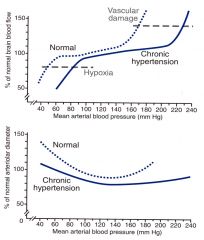![]()
![]()
![]()
Use LEFT and RIGHT arrow keys to navigate between flashcards;
Use UP and DOWN arrow keys to flip the card;
H to show hint;
A reads text to speech;
8 Cards in this Set
- Front
- Back
|
1. Define Autoregulation and discuss what happens to autoregulated organ blood flow at low and high perfusion pressures
|
1. Autoregulation is the maintenance of blood flow across a wide range of perfusion pressure
2. At low perfusion pressure vascular resistance decreases 3. At high perfusion pressure vascular resistance increases |
|
|
How does the heart meet increased oxygen demand and why? Does this organ autoregulate it's blood flow? |
1. Meets oxygen demand through increased blood flow
2. Autoregulates blood flow from 60-140 mmHg MAP |
|
|
1. Describe Rt Coronary and Lt Coronary blood flow thru the cardiac cycle
|
1. Right coronary artery blood flow is sustained in systole and diastole, less constriction of capillary bed so little restriction of flow during systole. Gets a little less than half the blood flow than left coronary artery.
2. Left coronary artery blood flow is very low during isovolumetric contraction, increases during ejection, and increases even more during diastole. Has more than half the blood flow to it. |
|
|
1. How is cerebral blood flow maintained fairly constant and what does chronic hypertension do to cerebral blood flow
|

1. Autoregulates at rest
2. Mechanisms – primary is myogenic arteries and arterioles and secondary is metabolic products 3. Insensitive to neurotransmitters |
|
|
Name the 2 main control mechanisms for striated muscle blood flow |
1. Local metabolites and autonomics
2. Degree of vasoconstriction here is major determinant of TPR |
|
|
1. Discuss how autonomic NS controls striated m. blood flow and where this occurs in the vasculature
|
1. NE is used to constrict the blood vessels at the local striated muscle at the alpha 1 receptor.
|
|
|
List 3 mechanisms of local metabolic control of muscle blood flow |
1. Autoregulation
2. Active hyperemia – lactate, adenosine, potassium 3. Reactive hyperemia – increased flow after muscle contraction/ishcemia |
|
|
Discuss how and why cutaneous blood flow is regulated. |
1. Primary control for body temperature
2. Inhibition of cutaneous system during exercise leads to dilation of arterioles 3. Minimal local vasodilator metabolites 4. trauma |

